Spicy Thai Basil Chicken
This post contains affiliate links.
This Spicy Thai Basil Chicken is a quick and easy and super tasty weeknight stir-fry! Diced chicken breasts pieces are tossed in a spicy, savory, and sweet sauce and served with warm steamed white rice and a yolky Thai style fried egg! Feel free to make it as spicy or mild as you like, vegetarian with tofu instead, and/or gluten-free if needed.
Buckle up friends!
Today, I’m going to be sharing one of my all-time favorite Thai dishes. It’s not only super delicious, but it’s super easy to make at home too!
We’re going on the Bangkok tuk tuk ride of your life with this mouthwatering, tingle-your-tastebuds tantalizing, proper street food style Spicy Thai Basil Chicken!
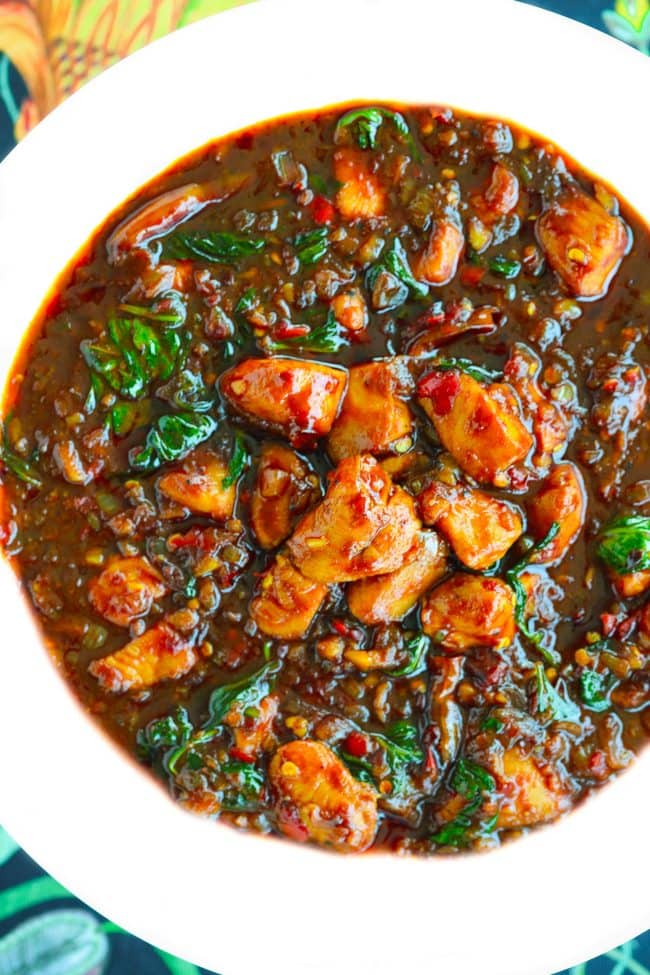
ABOUT SPICY THAI BASIL CHICKEN
This dish is similar to Spicy Thai Holy Basil Chicken (Pad Krapao Gai) – a dish that is popular in Thailand, and it’s guaranteed to be found on the menu at any Thai restaurant you visit. It’s a simple stir-fry dish that involves tossing garlic, chilies, shallots, minced chicken, and Thai Holy Basil in a sweet, salty, and spicy sauce.
However in my version of this classic Thai recipe, I like to use bite sized chicken breasts because it tastes juicier and more magnificent in the fiery sauce!
In addition, I use Thai Sweet Basil instead of holy basil because:
a. I adore its sweet aroma and the way its flavors really penetrate through any type of dish! 😍 I even use it in my Spicy Chicken Penne Pasta when I have it on hand!
b. Thai Holy Basil, a peppery tasting basil, is sadly not readily available everywhere. It’s seasonally available in Hong Kong, and I usually can only find it during the summer here.
On the other hand, you can usually find Thai Sweet Basil in wet markets in Asia or in your local Asian market at any given time of the year. In fact, I’ve even come across it in supermarkets here! And you guys know I’m all about convenience. So Thai Sweet Basil gets the green light for my Spicy Thai Basil Chicken!
If you do happen to chance upon Thai Holy Basil and want to make this dish like the more traditional version that you get at Thai restaurants and in Thailand, feel free to use it instead. I’ve used both types of Thai basils in this recipe and both taste great in this dish!
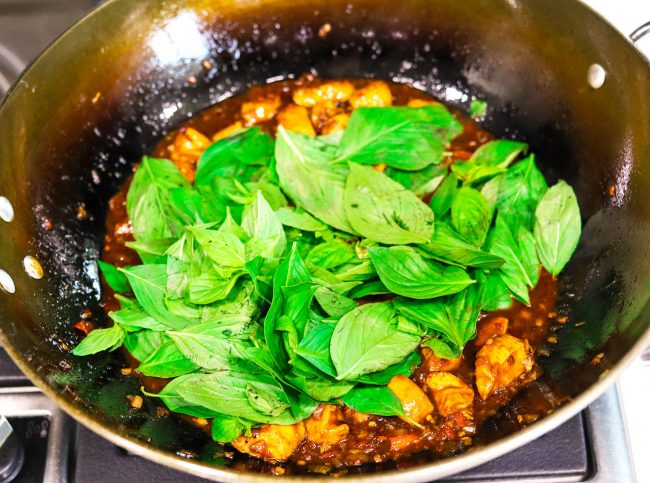
WHY YOU NEED THIS SPICY THAI BASIL CHICKEN IN YOUR LIFE STAT
- It’s quick and easy to make on any given weeknight. (WIN if you tend to get mega haaangry after a long day of work – like me – and just want to eat!)
- The super delicious sauce! ❤️ It’s salty. It’s sweet. And also a bit spicy thanks to bird’s eye chilies! We’re hitting all the best notes here folks!
- In addition, the amazing sauce is super flexible because it works well with chicken, shrimp, pork or beef slices, and even tofu! So feel free to use your favorite protein, and/or make this vegetarian with pan-fried tofu cubes. 👌
- That Thai Fried Egg guys, is the BOMB diggity! Just poke that egg yolk nice and easy with a spoon and watch it drizzle down into the chicken and rice. Now fill up a spoon with a bit of the chicken, rice, and a bit of that egg and tell me you don’t love it. I DARE YOU.
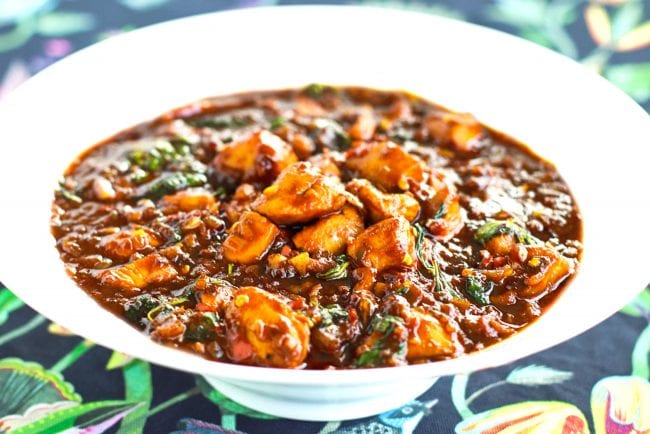
SPICY AND SWEET MAGIC!
As you know from the name of this blog, I love my spicy food. (Duh!)
But I also love food that is spicy and a bit sweet at the same time. This is why I’m a huge fan of Gochujang – a Korean chili paste that is not too spicy and has a hint of sweetness to it. I’ve used it in my other stir-fries such as my Spicy Kung Pao Chicken when I need a mild to medium hot chili paste.
In this dish, a bit of brown sugar and gochujang work well together to balance out the heat from the chili paste made from the hot Thai bird’s eye chilies. But don’t worry. If you’re not big on heat, you are most welcome to lower the spice level by reducing the amount of fresh chilies and gochujang. 😊
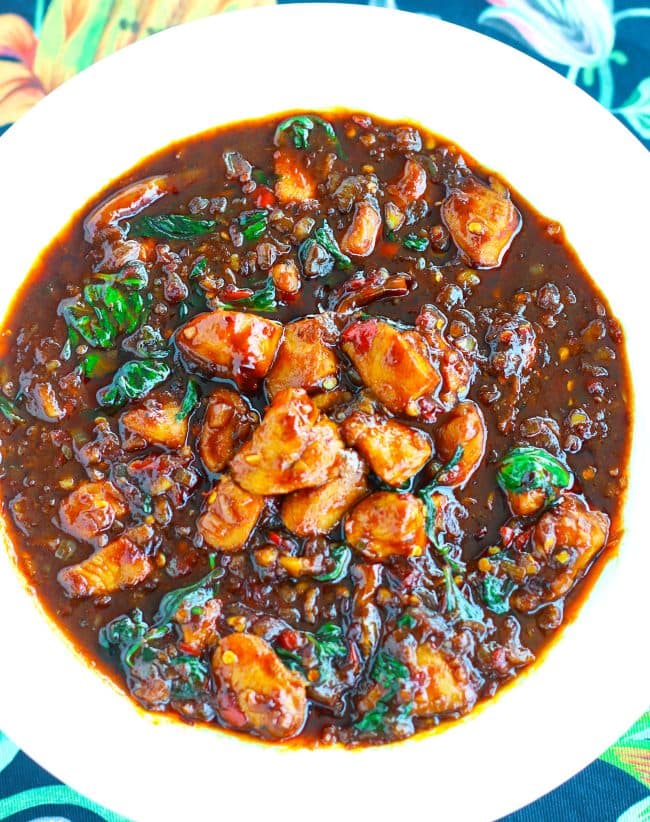
WHAT IS A THAI FRIED EGG?
So about that Thai Fried Egg. You must be wondering what makes it Thai. If you’ve ever been to Thailand and tried Spicy Thai Holy Basil Minced Chicken (or minced pork or beef), you’ve probably gotten a “deep-fried” egg that has a runny egg yolk and soft, but firm white part. Well, I’ve copied the technique here to get the same results, but I shallow fried the egg in less oil than they normally use. Why? Because I’m not running a restaurant or have to feed twenty people the same type of egg! Plus, why not use less oil if you can get away with it, right? Yes, I know I’m right!
Friends, please try it and see for yourselves that this homemade Thai fried egg is totally lovely and yolky! And it just makes this whole dish come together! 😋
It really is proper full-on YOLK-GASM, which is nom in my opinion. So do yourself a favor and make that marvelous egg to crown your glorious plate Spicy Thai Sweet Basil Chicken and rice!
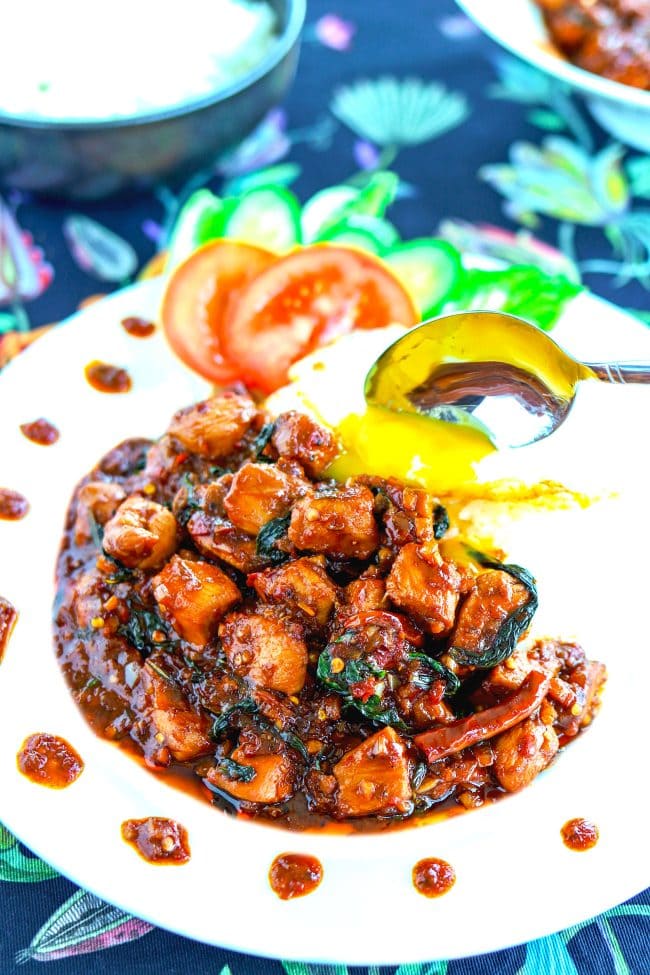
HOW TO MAKE SPICY THAI SWEET BASIL CHICKEN
To make this easy stir-fry in a few simple steps:
- Get all the prep work done: Chop the garlic, shallots (or red onion), and cut the red and green chili pieces into halves and thirds. Next, dice the chicken breasts into bite sized pieces and combine it with some cornstarch, low sodium soy sauce, Shao Xing rice wine, and a splash of sesame oil. Then, make the ‘sauce bowl’ by combining low sodium light soy sauce, sweet dark soy sauce, brown sugar, Sriracha sauce, oyster sauce, fish sauce, and gochujang in a bowl. In a mini blender, pulse the fresh red and green chilies with a bit of peanut oil (or any other cooking oil) to make a coarse chili paste. (Note: You can also use a mortar and pestle to smash the fresh chilies into a coarse paste. Or you can just finely mince the chilies too.)
- Make the Thai Fried Egg: Heat 4 TBLS of peanut oil (or any other oil with a high burning point) in a wok over high heat. Once the oil is hot and it starts to smoke a little, turn down the heat to medium and crack an egg into the wok. Move quickly now and use a spatula to “spoon oil” on top of the egg repeatedly to help it cook. Once the white part is cooked but the yolk is still runny on the inside, turn off the heat and carefully transfer the egg to a paper towel lined plate to drain off any excess oil. Repeat for the remainder eggs. (Note: If you have health concerns about eating a semi raw egg, feel free to continue frying it until the yolk has fully set and the egg is cooked to your desired doneness.)
- Half cook your chicken: Heat the peanut oil in the wok again, and stir-fry the marinated chicken pieces until almost fully cooked. Transfer to a fine mesh strainer and hold it above the wok to allow the excess oil to drip off. Then, transfer the chicken to a clean bowl and set it aside. Wipe out the wok with a paper towel and get ready to bring it all home!
- Start stir-frying: Start with the shallots (or red onion) and garlic, and then add the Thai dried chilies (if using). Add the half cooked diced chicken pieces and the homemade blended chili paste on top. Toss it all together, then pour in the contents of the ‘sauce bowl’ and combine. Then, throw in the Thai sweet basil leaves (and deeply inhale the fragrant aroma! 😍). Continue stir-frying to combine everything for a minute, then scoop it all out into a dish!
- Serve!: Serve the chicken over some warm steamed white rice – or brown rice, quinoa, or whatever is your game! Top with the Thai Fried Egg and enjoy!
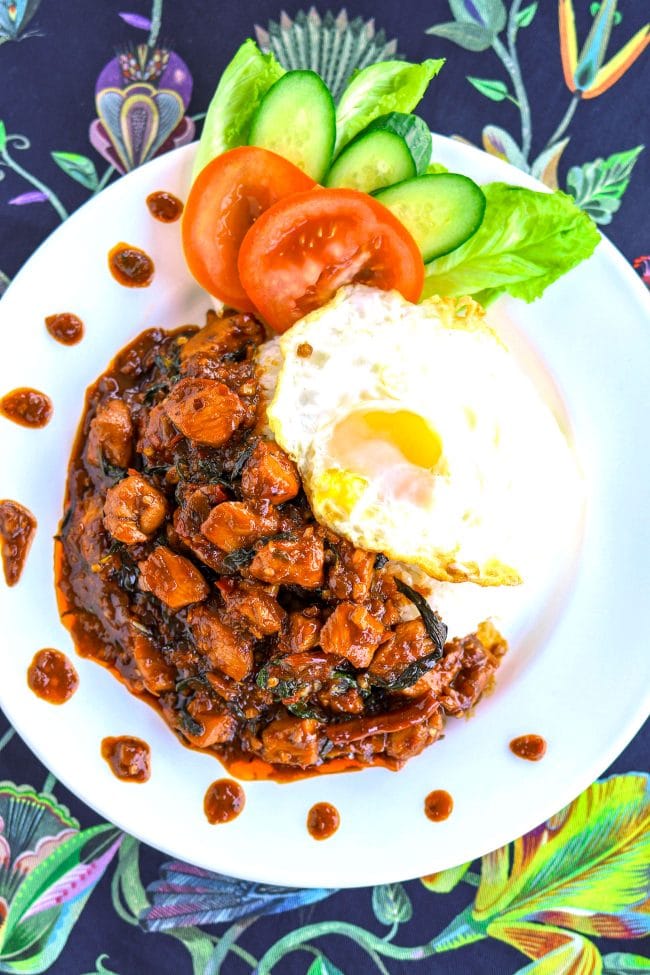
CAN I MAKE THIS GLUTEN-FREE?
Yes! Use a gluten-free soy sauce and a gluten-free oyster sauce. You should also use a gluten-free sweet dark soy sauce such as Chang’s Sweet Soy Kecap Manis Sauce, and a gluten-free gochujang like Wholly Gochujang. Be sure to double check that the brand of fish sauce you are using is also gluten-free. (Some fish sauces contain hidden gluten in the form of wheat.) I recommend Thai Kitchen Gluten Free Fish Sauce – it’s not overly salty like some other Thai and Vietnamese brands’ fish sauces are, and it works well in this recipe!
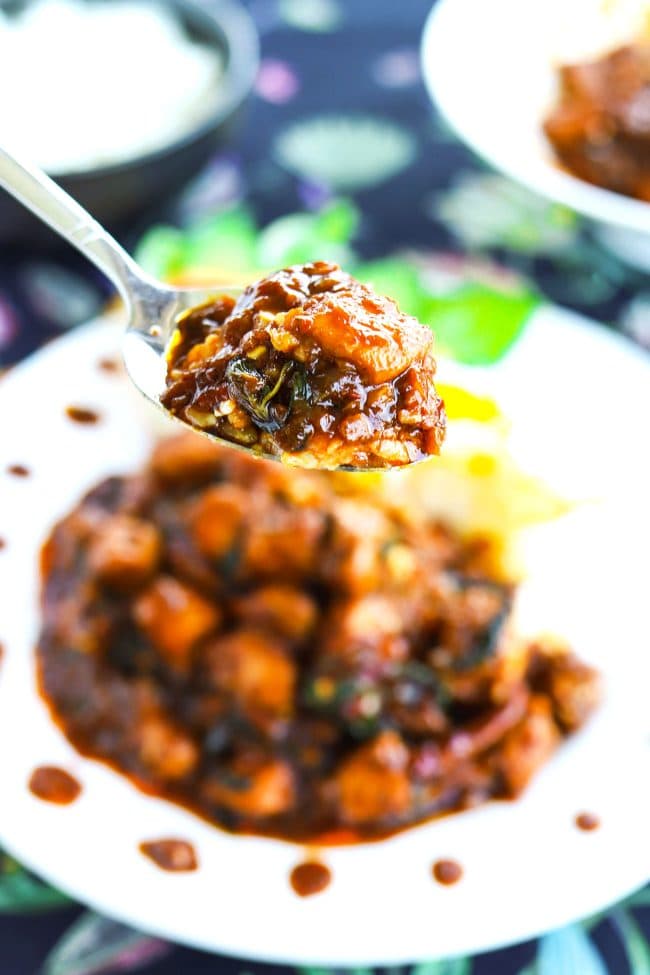
CAN I MAKE THIS VEGETARIAN?
Definitely! Instead of chicken, you can pan-fry some firm tofu cubes with a bit of salt and pepper. For the ‘sauce bowl’, use a vegetarian mushroom flavored oyster sauce, and a vegetarian fish sauce such as Fortuna Vegetarian Fish Sauce (Nuoc Mam Chay). Then toss the tofu in place of the chicken in the fiery and mouthwatering sauce!
As they say in Thailand, kin hai aroi na (enjoy your meal) my friends! 🤗
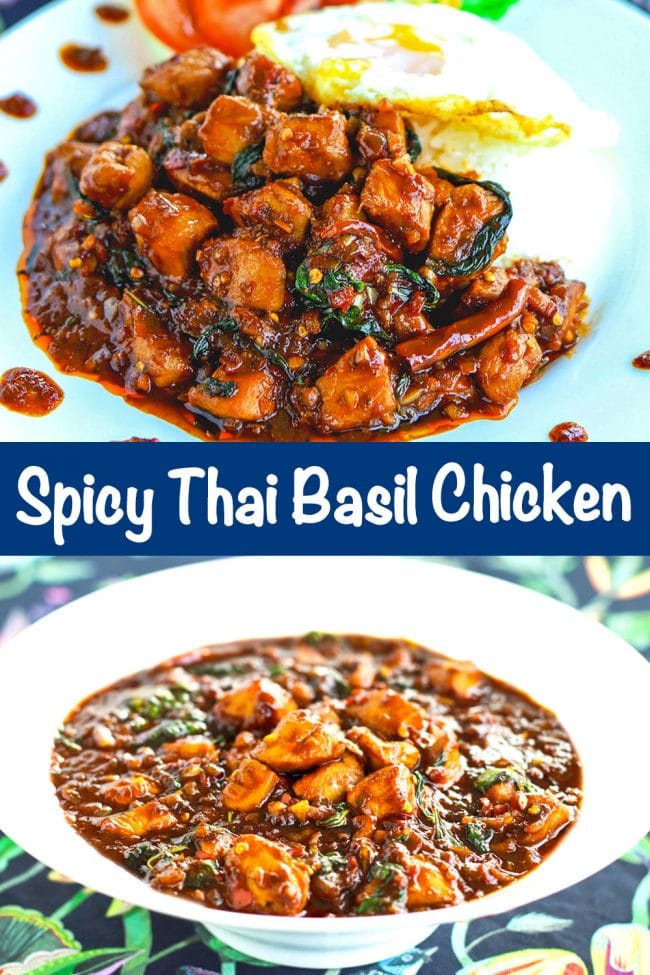
MORE QUICK AND EASY STIR-FRY RECIPES
If you like this recipe and are looking for other quick weeknight stir-fries, check out some of my favorites below!
- Crispy Tofu Spicy Fried Rice
- Spicy Kung Pao Chicken
- Stir-fried Pork Sukiyaki in Black Pepper Sauce
- Chili Garlic Shrimp
- Stir-fried E-fu Noodles with Shrimp
- Quick & Easy Chicken, Bacon, and Cabbage Stir-Fry
Or if you’re looking for more Thai recipes, browse the entire Thai recipe collection.
PrintSpicy Thai Basil Chicken
This Spicy Thai Basil Chicken is a quick and easy and super tasty weeknight stir-fry! Diced chicken breasts are tossed in a spicy, savory, and sweet sauce and served with warm steamed white rice and a yolky Thai style fried egg! Feel free to make it as spicy or mild as you like, vegetarian with tofu instead, and/or gluten-free if needed.
- Prep Time: 15
- Cook Time: 30
- Total Time: 45 minutes
- Yield: 2-3 1x
- Category: Chicken
- Method: Stir-fry
- Cuisine: Thai
Ingredients
- 7 Garlic cloves – minced
- 3–4 Shallots OR ¼ Red Onion – minced
- 4–10 Red Chilies (Bird’s Eye chilies preferred, but any small hot red chilies will work), to taste – deseeded if less heat is desired and roughly chopped
- 1–2 Green Chilies (Bird’s Eye chilies preferred, but any small hot green chilies will work), to taste – deseeded if less heat is desired and roughly chopped
- 2 Chicken Breasts (about 400 grams / 14 ounces), boneless, skinless – diced into bite-sized pieces
- 1.5 TSP Corn Starch
- 7 TSP Low Sodium Light Soy Sauce (use gluten-free soy sauce or Tamari if needed)
- 2 TSP Shao Xing Rice Wine
- 1.5 TSP Sweet Dark Soy Sauce (the thick and viscous type, use a gluten-free sweet soy sauce such as this one if needed)
- 1 TSP Sriracha Sauce
- 1 TBLS Oyster Sauce (use a gluten-free oyster sauce if needed)
- 1 TBLS Fish Sauce
- 1 TSP Brown Sugar
- 1 TBLS Gochujang Hot Pepper Paste (Or use any gluten-free chili paste. Wholly Gochujang is a gluten-free version of this Korean hot pepper paste)
- A generous pinch of Crushed Red Chili Pepper flakes, to taste
- A generous pinch of Black Pepper, to taste
- 5 TBLS Peanut Oil (or any other oil with a high burning point)
- 1 TSP Chili Oil (optional)
- 1.25 TSP Sesame Oil
- 3 Eggs (see notes*)
- 1 bunch (a little over 1 cup) Thai Sweet Basil leaves – picked off stems, then washed and pat-dried
- 2–3 Thai Dried Red Chilies (optional), to taste – cut each into half to release more heat (omit if you’re not big on heat)
- ¼ cup + 2-3 TBLS Water (as needed)
Instructions
Prep:
- Prepare the fresh ingredients: Mince the garlic, shallots (or red onion if using), and roughly chop the red and green chilies.
- Marinate the chicken: Mix together the corn starch, 3 TSP low sodium light soy sauce, Shao Xing rice wine, and 1/4 TSP sesame oil in a large bowl. Dice the chicken into bite-sized pieces and add to the bowl. Mix well to coat, then set aside.
- Make the sauce: In a measuring cup (or small bowl), whisk together the remainder 4 TSP low sodium light soy sauce, sweet dark soy sauce, brown sugar, Sriracha sauce, oyster sauce, fish sauce, and gochujang. Mix thoroughly to combine and set aside.
- Make the fresh chili paste: Add about ½ a TSP of peanut oil to a mini blender jug and swirl it around to coat the sides and bottom. Add the red and green chili pieces and cover with the lid. Pulse until the chilies have formed into a coarse chili paste. Transfer to a bowl and set aside. (Note: Alternatively, smash the chili pieces in a mortar and pestle to form a coarse chili paste, or finely mince instead.)
- Make the Thai-style fried eggs: Heat 4 TBLS of peanut oil in a wok over high heat. Once hot and starting to smoke a little, turn down the heat to medium and crack an egg into the wok. Move quickly now and use a spatula to spoon the oil on top of the egg repeatedly. Once the white part is cooked but the yolk is still runny on the inside, turn off the heat and carefully transfer the egg to a paper towel lined plate to drain. Repeat for the remainder eggs. (Note: If you have health concerns about eating a semi raw egg, feel free to continue frying the egg until the yolk has fully set and the egg is cooked to your desired doneness.)
- Cook the marinated chicken: Turn on stove again and set to medium-high heat. Add a splash of sesame oil to the peanut oil already in the wok. Lift and rotate the wok in a circular motion so that the oil spreads around the perimeter, then place it back on the stove to let the oil heat up. Once hot, add the chicken and spread evenly in the wok. Let the chicken cook and brown for about 1 minute, then start tossing and flipping the pieces. Stir-fry for another minute, until almost cooked through, then transfer to a fine mesh strainer and hold above the wok to let the oil drain. (You can gently shake the strainer to speed up the draining process, but be careful not to shake too vigorously as it can cause some of the cornstarch to come off and make the chicken mushy.) Transfer the chicken into a clean bowl and set aside. Discard the oil and wipe out the wok with a paper towel, then set it back on the stovetop.
For the Spicy Thai Basil Chicken:
- Sauté aromatics and dried red chilies: Heat the remaining 1 TBLS of peanut oil, 1 TSP chili oil (if using), and 1 TSP of sesame oil in the wok over medium-high heat. Once hot, add the shallots and garlic, and sauté for about 1 minute until fragrant. Then add the Thai dried red chilies and stir-fry to combine.
- Add the chicken and fresh chili paste: Add the almost fully cooked chicken pieces back into the wok and spoon the fresh red chili paste on top. Stir-fry to coat the chicken with the paste.
- Pour in the sauce: Pour the sauce on top of the chicken and stir-fry to combine everything until everything is coated in the sauce.
- Add water: Stir in ¼ cup water, and allow to simmer for 30 seconds to a minute. The sauce should start to thicken.
- Season: Add the crushed red chili pepper flakes and black pepper to taste (if using), and stir-fry to combine for 1-2 minutes. At this point if it becomes too dry, stir in 2-3 tablespoons of water as needed.
- Stir through basil: Add the Thai sweet basil leaves and stir until wilted and the sauce has thickened again – about 30 seconds. Then switch off the heat.
- To Serve: Transfer to a serving dish and serve with steamed white rice, brown rice, or quinoa. Top each plate with a Thai-style fried egg, then enjoy!
Notes
- Chilies: Feel free to adjust the quantity or leave out the fresh red and green chilies, Thai dried red chilies, and crushed red chili pepper flakes if you want to make this dish less spicy.
- Eggs: I recommend using 1 egg per serving, but it’s totally up to you how many you want to cook and have. In my house, EVERYONE wants their own Thai Fried Egg…and how could they not! 😉
- To make this gluten-free: Use a gluten-free soy sauce and a gluten-free oyster sauce, and dry sherry instead of Shao Xing rice wine. You should also use a gluten-free sweet dark soy sauce such as Chang’s Sweet Soy Kecap Manis Sauce, and a gluten-free gochujang like Wholly Gochujang. Be sure to double check that the brand of fish sauce you are using is also gluten-free. (Some fish sauces do contain hidden gluten in the form of wheat.) I recommend Thai Kitchen Gluten Free Fish Sauce – it’s not overly salty like some other Thai and Vietnamese brands’ fish sauces are, and it works well in this recipe!
- To make this vegetarian: Instead of chicken, you can pan-fry some firm tofu cubes with a bit of salt and pepper and use it instead. For the ‘sauce bowl’, use a vegetarian mushroom flavored oyster sauce, and a vegetarian fish sauce such as Fortuna Vegetarian Fish Sauce (Nuoc Mam Chay). Then toss the tofu in place of the chicken in the fiery and mouthwatering sauce!
Nutrition
- Serving Size: 1 bowl
- Calories: 432
- Sugar: 14.2g
- Sodium: 1655.9mg
- Fat: 17.8g
- Saturated Fat: 3.8g
- Unsaturated Fat: 11.6g
- Trans Fat: 0g
- Carbohydrates: 27.1g
- Fiber: 3.2g
- Protein: 41.7g
- Cholesterol: 283.3mg
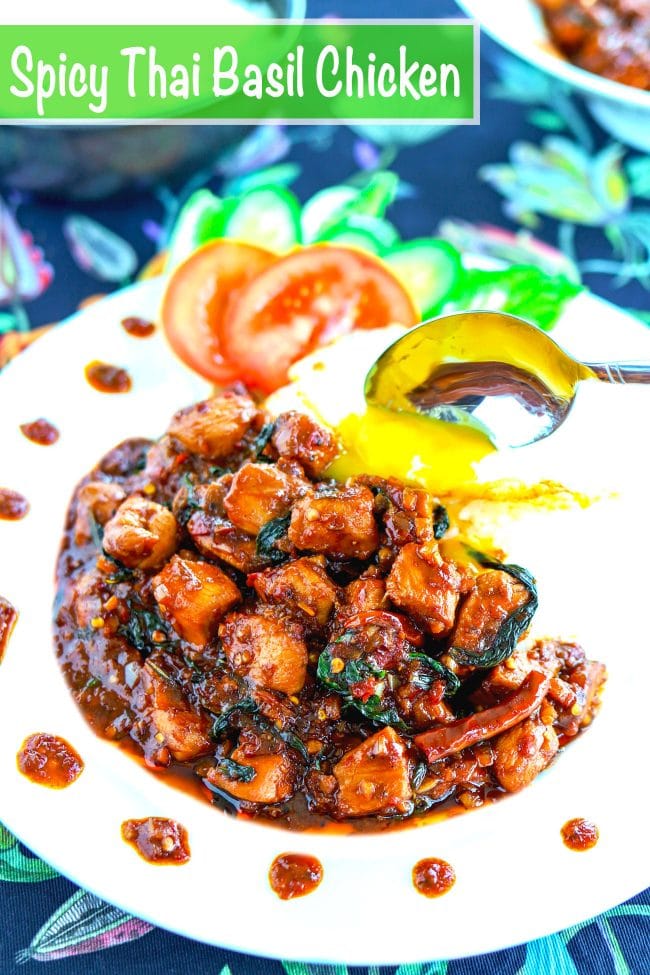
This post may contain affiliate links. We are a part of the Amazon Services LLC Associates Program, an affiliate advertising program designed to provide a means for us to earn a small commission (at no extra cost to you) by linking to Amazon.com and affiliated sites. The nutritional information provided is approximate and can vary based on several factors. It should only be used as a general guideline. For more information, please see our Disclosure.

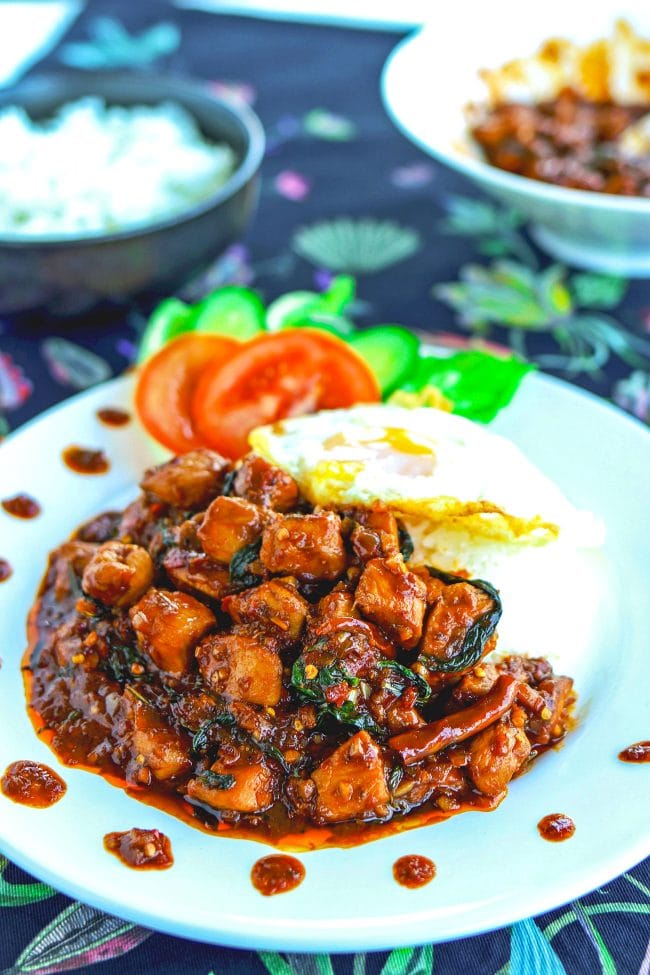














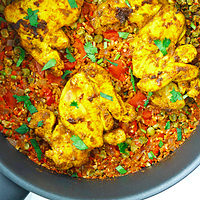





This is one of the most authentic tasting Thai Basil recipes I’ve had the pleasure of making and eating, and I’ve eaten at Thai restaurants all over the U.S., plus in Thailand too! Can’t wait make this for my friends and family-thank you so much Lavina for sharing this delicious recipe!! <3
Awesome Gaby! I’m so happy you enjoyed this recipe!! You’re most welcome, and I hope your family and friends love it too! 🙂
Thanks, great recipe and nicely explained!